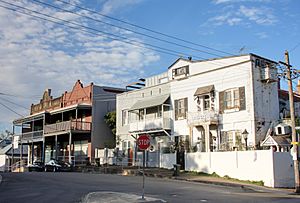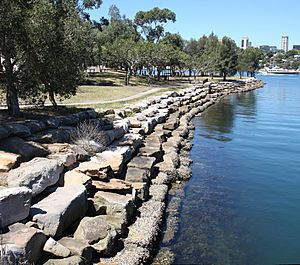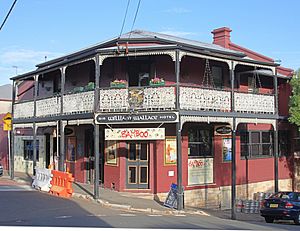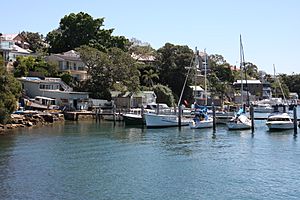Birchgrove, New South Wales facts for kids
Quick facts for kids BirchgroveSydney, New South Wales |
|||||||||||||||
|---|---|---|---|---|---|---|---|---|---|---|---|---|---|---|---|
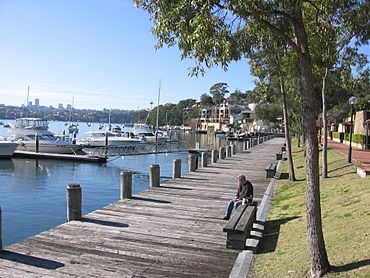
Birchgrove, New South Wales
|
|||||||||||||||
| Population | 3,228 (2021 census) | ||||||||||||||
| • Density | 5,760/km2 (14,900/sq mi) | ||||||||||||||
| Established | 1836 | ||||||||||||||
| Postcode(s) | 2041 | ||||||||||||||
| Elevation | 23 m (75 ft) | ||||||||||||||
| Area | 0.56 km2 (0.2 sq mi) | ||||||||||||||
| Location | 5 km (3 mi) west of Sydney CBD | ||||||||||||||
| LGA(s) | Inner West Council | ||||||||||||||
| State electorate(s) | Balmain | ||||||||||||||
| Federal Division(s) | Grayndler | ||||||||||||||
|
|||||||||||||||
Birchgrove is a lovely suburb in Sydney, Australia. It's in the Inner West part of the city, about 5 kilometers (3 miles) west of the main city center. Birchgrove sits on a hill overlooking the beautiful Sydney Harbour. It's known for its stunning water views and is considered one of Sydney's wealthier areas.
Birchgrove is located on the Balmain peninsula. It includes two special points of land called Yurulbin and Ballast Points. From its long waterfront, you can see the Parramatta River and Cockatoo Island. The only suburb right next to Birchgrove is Balmain.
Contents
History of Birchgrove
Birchgrove got its name from a house called Birchgrove House. This house was built around 1812 by Lieutenant John Birch. He added 'grove' to his name because there were many orange trees growing on the land. The house was made from stone, likely dug up right there.
Over the years, the land changed owners many times. In the 1850s, a man named Didier Numa Joubert owned the estate. He decided to divide the land into smaller blocks to sell. Streets in the area were named after his family.
From the 1860s, many businesses opened along the waterfront. These included boat builders and shipyards. More land was sold off from Birchgrove House in the late 1800s. This helped the area grow even more.
A special old house called Clifton Villa is in Birchgrove. It's a three-story sandstone house built in the 1860s. It has a covered porch and a ballroom that was added later. Inside, you can see a marble fireplace and beautiful wooden details. Clifton Villa is now a protected heritage site.
Birchgrove was also home to the Balmain Colliery, which was Australia's deepest coal mine.
Old Tram Line
Long ago, there were tram services in Birchgrove. Trams would travel from Darling Street in Balmain and end at Wharf Road in Birchgrove. Today, a bus service follows this old tram route.
Underwater Railway Tunnel
Birchgrove is home to the southern entrance of the first tunnel ever built under Sydney Harbour! This tunnel was dug by hand starting in 1913 and finished in 1924. It was built to carry electricity cables from the Pyrmont Power Station to the tram network on the north side of the harbour. Before the tunnel, cables were laid on the harbour floor, but ships' anchors kept damaging them.
The tunnel goes through solid rock deep below the harbour. At its lowest point, it's about 72 meters (236 feet) below sea level. It's a really cool piece of history and is now listed on the New South Wales State Heritage Register.
Historic Places
Birchgrove has several places that are listed for their historical importance:
- 144 Louisa Road: Raywell
- 25 Wharf Road: Wyoming
- Sydney Harbour railway electricity tunnel
Landmarks to See
- Ballast Point Park is a large park (2.6 hectares or 6.4 acres) right at the tip of the Balmain Peninsula. It used to be an industrial site but is now a beautiful public space.
- Yurulbin Park is another park located at the end of Yurulbin Point. It used to be a place where ships were built, but now it's a lovely public area that has won awards.
Getting Around
The Birchgrove ferry wharf is where you can catch ferries. These ferries can take you to Circular Quay and Cockatoo Island.
Buses also run through Birchgrove. You can catch a bus from Birchgrove Park to the Art Gallery of New South Wales. During busy times, some buses end their journey at the Queen Victoria Building (QVB).
Fun and Recreation
Birchgrove is home to the Balmain Sailing Club. This club hosts the yearly Balmain Regatta, which is a sailing race. It's believed to be the oldest regatta in Australia, first held way back in 1849!
People of Birchgrove
In 2021, there were 3,228 people living in Birchgrove. Most people (69.1%) were born in Australia, but many also came from England (10.0%) and New Zealand (2.4%). Most people speak English at home.
Birchgrove is known for being a wealthy area. The average weekly income for households here is much higher than the average for Australia. Many people in Birchgrove work as professionals or managers. Birchgrove also has the highest number of people with postgraduate degrees (like a Master's or PhD) compared to any other suburb in Sydney!
Famous People from Birchgrove
Many well-known people have lived in Birchgrove, including:
- Bryan Brown – an actor
- Rhonda Burchmore – an actress and singer
- Judy Davis – an actress
- David Williamson – a playwright (someone who writes plays)
Schools
- Birchgrove Public School
Churches
- St John's Anglican Church
Images for kids


